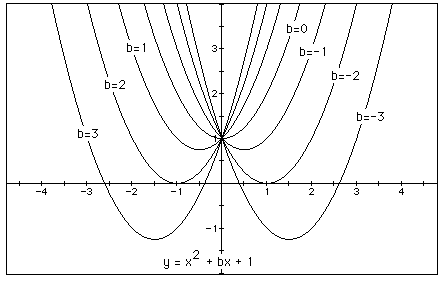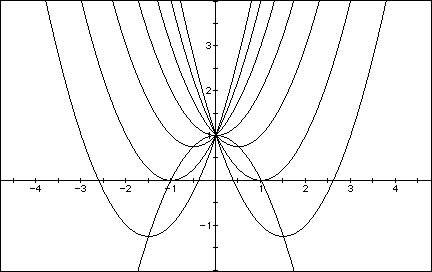
The Department of Mathematics Education
J. Wilson, EMAT 6680

It has now become a standared exercise, with available technology, to construct graphs to consider the equation
and to overlay several graphs of
for different values of a, b, or c as the other two are held
constant. From these graphs discussion of the patterns for the
roots of
can be followed.
Consider graphs for varying values of b.
For example, if we set
for b = -3, -2, -1, 0, 1, 2, 3, and overlay the graphs, the
following picture is obtained.

We can discuss the "movement" of a parabola as b
is changed. The parabola always passes through the same point
on the y-axis ( the point (0,1) with this equation). For b <
-2 the parabola will intersect the x-axis in two points with positive
x values (i.e. the original equation will have two real roots,
both positive). For b = -2, the parabola is tangent to the x-axis
and so the original equation has one real and positive root at
the point of tangency. For -2 < b < 2, the parabola does
not intersect the x-axis -- the original equation has no real
roots. Similarly for b = 2 the parabola is tangent to the x-axis
(one real negative root) and for b > 2, the parabola intersects
the x-axis twice to show two negative real roots for each b.
Now consider the locus of the vertices of the set of parabolas
graphed from
The locus is the parabola
Therefore,

Consider again the equation
Graphing this relation in the xb plane, the following graph
results.

If we take any particular value of b, say b = 3, and overlay
this equation on the graph we add a line parallel to the x-axis.
If it intersects the curve in the xb plane the intersection points
correspond to the roots of the original equation for that value
of b. We have the following graph.

For each value of b we select, we get a horizontal line. It
is clear on a single graph that we get two negative real roots
of the original equation when b > 2, one negative real root
when b = 2, no real roots for -2 < b < 2, One positive real
root when b = -2, and two positive real roots when b < -2.
Consider the case when c = - 1 rather than + 1. Therefore,

It is clear that we will always obtain two real roots (one positive and one negative) for any value of b.
Consider the algebraic connection. The discriminant (obtained from the quadratic formula) describes the number of real solutions. Describe why changing c = 1 to c = -1 makes such a significant difference in the number of real solutions.
Remember,
b2 - 4ac = 0, results in one real solution.
b2 - 4ac > 0, results in two real solutions.
b2 - 4ac < 0, results in no real solutions.
In the following example, the equation
is considered. If we set c = -4, 0, 4, 8, and overlay the graphs, the following picture is obtained.

The locus of the vertices of the set of parabolas is vertical line x = -2.
We can discuss the "movement" of a parabola as c is changed. The parabola passes through the y-axis at (+c) or (-c) units. For c < 0, the parabola will intersect the x-axis with one positive and one negative value (i.e. the original equation will have two real roots, one positive and one negative). For 0 < c < 4 the parabola will intersect the x-axis in two points with negative x values (i.e. the original equation will have two real roots, both negative). For c = 4, the parabola is tangent to the x-axis and so the original equation has one real and negative root at the point of tangency. For c>4, the parabola does not intersect the x-axis -- the original equation has no real roots.
Graphs in the xc plane.
If the equation is graphed in the xc plane, it is easy to see
that the curve will be a parabola. For each value of c considered,
its graph will be a line crossing the parabola in 0, 1, or 2 points
-- the intersections being at the roots of the orignal equation
at that value of c. In the graph, the graph of c = 1 is shown.
The equation
will have two negative roots -- approximately -0.28 and -3.73.

graph in xc plane
c = 1
x2 + 4x + c = 0
There is one value of c where the equation will have only 1 real root -- at c = 4. For c > 4, the equation will have no real roots and for c < 4 the equation will have two roots. Both roots will be negative for 0 < c < 4, one root will be negative and one 0 for c = 0, and one root will be negative and one positive when c < 0.
Consider the case when b = -4 rather than +4.

graph in xc plane
c = 1
x2 + 4x + c = 0
x2 -
4x + c = 0
Consider the algebraic connection. The discriminant (obtained from the quadratic formula) describes the number of real solutions. Describe the effect that changing b = 4 to b = -4 has on the number and type of real solutions.
Consider graphs with varying values for a.
In the following example the equation
is considered. If we set a = -2, -1, -0.5, 0, 0.5, 1, 2, and overlay the graphs, the following picture is obtained.

When a = 0, the equation is no longer quadratic, but linear. This line, y = x + 1 represents an asymptote between the graphs of the equations in which a < 0 and a > 0. All of graphs pass through the same point on the y-axis (the point (0,1) with this equation), and are tangent to one another at that point, the y-intercept. The locus of the vertices of the set of parabolas is the line y = (1/2)x + 1.

Graph of the locus of vertices at
y = (1/2)x + 1.
Consider different values of a to learn more about the roots of an equation when a varies. If we set a = 0, 0.2, 0.25, 1, and overlay the graphs, the following picture is obtained.

We can discuss the "movement" of a parabola as a is changed. The parabola always passes through and is tangent to the same point on the y-axis ( the point (0,1) with this equation). For a < 0 the parabola will intersect the x-axis in two points, with one positive and one negative x value (i.e. the original equation will have two real roots, one positive and one negative). For a = 0, the equation is linear with a negative root. For 0 < a < 0.25, the parabola will intersect the x-axis in two points with negative x values (i.e. the origingal equation will have two real roots, both negative). For a = 0.25, the parabola is tangent to the x-axis and so the original equation has one real and negative root at the point of tangency. For a < 0.25, the parabola does not intersect the x-axis -- the original equation has no real roots.
Graphs in the xa plane.
Consider again the equation
Graphing this relation in the xa plane, the following graph results.

Graph in the xa plane
ax2 + x + 1 = 0
a = -1
When a = -1, the equation will have two real roots, one positive and one negative -- approximately -0.61 and 1.61. There is only one value of a where the equation will have only one real root -- at a = .025. For a > 0.25, the equation will have no real roots. For 0 < a < 0.25, the equation will have two negative real roots. For a = 0, the equation is linear and has one real negative root. The line of a = 0, represents an asymptote for the number and types of real solutions between +a and -a. For a<0, the equation will have two real roots, one positive and one negative. As a approaches negative infinity, the two real solutions approach x = 0.
Consider the case when c = -1 rather than +1.

Graph in the xa plane
ax2 + x - 1 = 0
ax2 + x + 1 = 0
a = -1
It is clear that a must have the opposite sign in order to have the same number of real solutions, and as a result, the real solutions will also have opposite signs.
Consider the algebraic connection. The discriminant (obtained from the quadratic formula) describes the number of real solutions. Describe why changing c = 1 to c = -1 makes such a significant difference in the number of real solutions.
We welcome your questions and comments concerning this activity. We realize that each approach (xb, xc, and xa) could serve as an individual activity and be explored in more detail. We are interested in your opinion . Send e-mail to jwilson@coe.uga.edu and/or dwise@yahoo.com.
Return to David Wise's homepage.
Return to Jim Wilson's homepage.